|
Olympus Stylus 770 SW
Shockproof. Waterproof. Freezeproof. Crushproof.
(by Conrad H. Blickenstorfer)
Olympus is good to divers, snorkelers and those who do not constantly want to baby their cameras. They have weatherproof models in their lineup that do not mind a bit of rain or an occasional splash. They also offer dedicated deepwater housings and they make cameras that you can take underwater without a housing at all. Last fall we reviewed the Olympus Stylus 720 SW that's waterproof to a depth of 10 feet. I took it swimming and snorkeling with the Manatees at Crystal River, Florida, snapping pictures of those gentle creatures in the shallow water. Later, I put the 720 SW into its optional PT-033 deepwater housing for diving at Devil's Den in Williston and Catfish Hotel sink at Manatee Springs State Park. It was great not to have to worry about getting the camera wet. It was great to have a waterproof camera and I appreciated the 10 feet depth rating, but for most scuba diving you still needed an underwater case.
Enter the Olympus Stylus 770 SW. You can take this camera down 33 feet without a housing. That's diving.
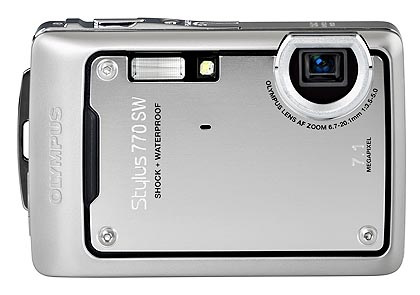
The 33-feet depth rating changes everything. The older 720 could probably have handled 15 or 20 feet, making it suitable for drift diving in a shallow river but not much more. 33 feet, that's another story. My log shows many dives that never took me much deeper, and some not even that. So if you plan to go diving in 30-40 feet water, no need for a housing with the Stylus 770. A bit deeper? I believe if the camera is rated 33 feet, it can probably handle 40 or even 50. And we put that to the test.
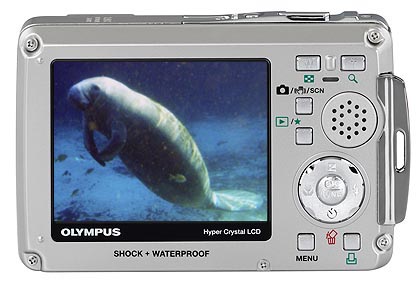
Being able to take this camera down to 33 feet is not all. Olympus made it tough all over. You can drop it from five feet and it won't break (but it may get scratched and dented a bit). It can operate in temperatures down to 14 degrees, so no matter how cold the water gets, the 770 can handle it. Olympus also claims the 770 to be crushproof to 220lbf, which the promo materials define as pounds of pressure. That's a bit hazier as "lbf" is really a unit of force. One pound-force means a one-pound mass pressing down on the surface of the earth. The question is, per what? Concentrated into a stiletto heel that'd be an awful lot. Applied via a large, soft mat it would amount to very little. I am not sure how much pressure the 770 can take per, say, square inch or onto one of its more vulnerable parts, like the LCD or a seal. Anyway, it's quite crushproof.
What's new and different?
At first sight, not much. The new Stylus 770 looks much like the older 720. Same overall design, virtually identical size, boxy metallic body and quite handsome. Side by side you quickly see that while it's the same design look, the 770 is really totally different down to almost every detail. You'd think it'd might make sense to carry over parts, but apparently not. For example, while button placement is identical, the 720's buttons were round whereas the 770's are square. This is a totally redesigned camera that just so happens to look at lot like its predecessor. The most notable visual difference is the front that has a screwed-on faceplate that comes in three different colors (silver, bronze, royal blue) whereas the 720 had a nicely integrated brushed steel front. Interestingly, the one aspect of the 770 that you'd expect to be different, the ever-important rubber O-rings and seals, are identical. Apparently they didn't need improvement.
Many of the specs are the same. The 770 SW is still a 7.1 megapixel camera and has an internal 3X zoom lens. Image quality settings now include an additional 16:9 aspect ratio mode that records at 1920 x 1080 pixels, a size well suited for viewing on high definition TVs. Aperture, shutter speeds, ISO ratings are all the same. The similarities carry over to the movie mode where you're still limited to pokey 15 frames-per-second 640 x 480 recording. And you still can't do voice recording other than brief 4 second audio clips. Internal memory is about the same -- an 18MB reserve in case you run out of storage on the xD-Picture card. The battery is the same as well, a 3.7V/740mAH Li-Ion rechargeable.
We had hoped for the optical, active image stabilization that so dramatically differentiated the Stylus 750's image quality and sharpness from that of the Stylus 740 that only has digital image stabilization. Unfortunately, the 770, too, only offers the digital kind which "fakes" stabilization by decreasing shutter speed and increasing sensitivity.
Superb, high-res LCD with 180 degree viewing angle
What has changed, dramatically, is the display. At 2.5 inches diagonal it's no bigger than the 720's, but whereas that was an unimpressive low-res affair with 115k pixels, the 700 has a gorgeous "HyperCrystal" LCD with twice the pixels, 230k. What's barely mentioned in the literature is that the new screen has essentially a 180 degree viewing angle in all directions. That in stark difference to the 720's screen that had a very narrow vertical viewing angle. The difference is amazing. With the 770, you never have to hold the camera in a certain way to see the picture. You can always see it.
LCD illumination
While the 770's flash is the same as that in the 720, it has something extra, an LED illuminator. That is a small light source not meant as a flash replacement, but to assist in seeing what you take a picture of in the dark. I heard it referred to as a "modeler." It works very well. Hold down the Menu button to turn it on, and again to turn it off. There's also a new second super macro mode that also turns on this LED light. The only criticism is that it's not obvious how it turns on and off; a separate light button would have been better. Don't want to disturb subjects longer than necessary. And, hey, if you're doing (shallow) caves, you might consider the 770 SW your 4th backup lightsource,
Manometer
A manometer is a pressure gauge, and the 770 SW, befitting an underwater camera but unusual nonetheless, has one. It's mounted on the right side of the camera behind a little grille that I first thought was a microphone. You can turn it on or off, and calibrate it. Underwater it reads to 33 feet and the camera will start beeping and flash a warning if you approach that depth. The depth is also displayed on the LCD.
Will the PT033 underwater case fit?
If you want to take this camera much deeper than 33 feet you need an optional deepwater case. Many current 720 SW owners will undoubtedly be attracted to the 770 due to its much better LCD, manometer, and greater depth rating. Some will have invested in the PT-033 housing for the 720. With all controls of the 770 being in exactly the same spot as on the 720 SW, and with the cameras being virtually the same size, we hoped the PT-033 case would fit. Alas, it doesn't. The 770 is a small fraction of an inch wider and the 770 won't go in. From looking at the case, it seems that it could be made to fit by filing down a couple of internal retaining bumps, but that's a "we think it would" and not a given. Fortunately, Olympus, in its best underwater-friendly fashion, is offering the PT-035 case specifically made for the Stylus 770 SW.
Shooting and Underwater modes
The 770 is a point & shooter without manual modes. Instead, you get to pick from a bunch of scene modes for almost any shooting scenario possible. They are the essentially the same as those in the older 720. The "museum" mode is gone, and that leaves a total of 27 modes including four special underwater shooting modes. Those are:
Underwater Wide-Angle 1 for shooting scenes and reefs. This mode emphasizes the blues.
Underwater Wide-Angle 2 for shooting slow moving fish. This mode won't flash as that can frighten the animals and is actually not allowed in some diving areas.
An underwater macro mode that seeks to accurately recreate the colors underwater and can be used with flash.
There is also an underwater snapshot mode that's recommended when you just fool with the camera in a pool or lake.
Controls and operation
The 770's controls follow current digital camera design trends with a 4-way navigation ring where each direction also brings up major functions (flash, exposure, macro mode, timer); four small buttons that call up the onscreen menu, switch to playback or shooting mode, and access print functions. Zoom is handled by two small buttons. The shutter is on top, right next to the slightly recessed on/off button.
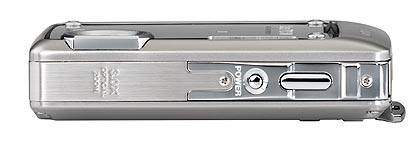
Like most other digicams, the 770 SW uses a mix of text, icons and embossings to label all functions. What's mercifully missing is different colors as well. All text and icons are either engraved or white. We hope the printed markings hold up. They sure aren't terribly readable, and especially not underwater. The onscreen menus are of the new and improved kind already seen on the 720. The menu system is improved and clearer than what was found on older Olympus cameras. The 770 has a few more options, but they are all pretty much self-explanatory (though a help feature would have come in handy).
A debatable design decision from the 720 carries over: It simply makes no sense to use the "record" button to also toggle into "image stabilization" mode and then into scene selection. I'd much rather have one button that toggles between record and playback, and another that brings up the various modes.
Features
While the Stylus 770 SW does not have manual controls you can set white balance, ISO, drive, autofocus, and such. Macro mode lets you get as close as eight inches and zoom is available in macro. In super macro mode you get as close as 2.8 inches, but the zoom is fixed. And then there's the above mentioned super macro with LED illumination. We already criticized the movie mode for allowing only 15 frames per second, and the camera doesn't have any cool special movie modes. You can shoot movies underwater, which is fun and works remarkably well. During playback of movies you have your choice of normal speed, 2X or 20X. You can also pause and then step through the movie frame by frame. That is a nice feature that in part makes up for the lack of some of the fancy movie tricks. Unlike the 720's skimpy 26-page manual and the rest on CD, you get a comprehensive and useful printed 80-page manual.
We often mentioned that Olympus cameras seem to concentrate on basics or are designed for a specific purpose, such as using a long zoom or, in this case, the ability to take the camera underwater or subject it to a beating. Those who seek a lot of features may feel a bit left out. The Panorama shooting mode is nice (it shows you on the LCD how to align up to ten pictures horizontally and vertically) and the supplied Olympus Master software does a good job stitching it all together. Like almost all Olympus cameras, the 770 uses the xD-Picture Card format as opposed to the more popular and more readily available SD Cards that usually cost less to boot. And in order to be able to use the panorama feature, you need to get not just any xD-Picture Card, but an Olympus xD-Picture Card.
In playback mode, you can zoom in in ten steps, and pan around in 20 step increments both horizontally and vertically. There are also limited on-board editing functions such as redeye fix, changing to sepia or black & white, changing brightness and saturation, adding a frame, adding text in different orientations, and even creating a calendar with a picture on it. You can also downsample the picture to VGA (640 x 480) or QVGA (320 x 240), do a slideshow, or tag images for printing. You can also allocate pictures to albums. Personally, I'll always do all of that sort of stuff on the computer, in my favorite imaging software application, but I suppose it serves its purpose.
Audio fans still do not have much to smile about. There is the same basic audio function that lets you add a mere four seconds of sound to a picture. You can't do longer annotations, and there is no separate audio recording feature.
Underwater shooting
I took the 770 on a dive trip to Northern Florida (together with an Evolt 330 with deepwater housing) to see how well it worked at depth and how it felt to go diving with a camera that wasn't big and bulky. I expected the wide viewing angle of the much better LCD to make a huge difference. And I hoped the depth warning beep would be loud enough so I wouldn't forget the limit.
Taking this camera in and under water is always an experience. Whoever sees it will immediately ask what it is and whether it won't flood. Then you explain that not only can the camera get wet, but you can take it down to 33 feet.
As is, the 770 saw action in several demanding dive locations. We took it to the Devil's Den sinkhole at Williston, a prehistoric cavern, then moved on to Crystal River where we spent hours snorkeling and swimming with Manatees, then a two hour drift dive down Rainbow River, and finally a dive at the Catfish Hotel sink at Manatee Spring State Park. Would the 770 turn out to limit our dives in deeper locations? Should we risk taking it below the 33-feet mark? We decided we would try.
As stated earlier, the 770 SW has a manometer that shows altitude. Above ground it is in relatively meaningless 600 feet increments. Underwater the increment is 1.5 feet, with the depth being displayed on the LCD. Below is an actual picture of the Stylus 770 at 25.5 feet. It was taken with an Olympus Evolt 330 dSLR. The image on the LCD is real, not superimposed. The screen shows exactly what the 770 saw at that moment.
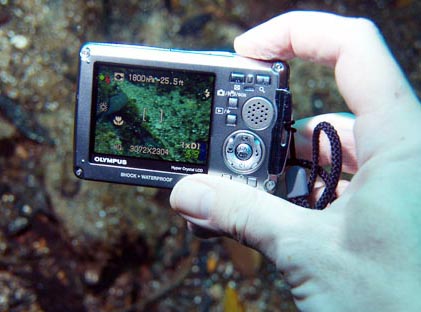
Going deep
Devil's Den has nooks and crannies that go as deep as 55 feet, though most divers stay in the shallower waters that has a number of platforms for checkout and training dives. After explaining the talents of the 770 to some fellow divers we went under and began taking pictures with the waterproof Olympus. The water was very clear, with sunrays shining through the narrow opening above the cavern's roof. As we've come to expect from underwater cameras, relatively lowlight conditions in telephoto mode is not their favorite, and I did not expect miracles from the 770 in that regard. Still, I got some excellent pictures of hovering divers caught in the sunbeams. Then I went deeper. As I approached 30 feet, the camera began beeping loudly and flashed a red "depth alert." I ignored it and went deeper. 35 feet, 40 feet, and the Olympus continued to work just fine. However, the manometer did not display depths greater than 33 feet. Instead, it kept showing 33 feet along with the red "depth alert" message.
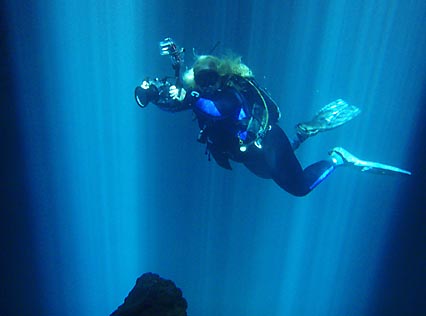
I came across the entrance to a small cave passage and decided to go down and into it. At its bottom I stopped and my dive computer showed 51 feet. I used my flashlight to read the buttons on the Olympus and tried to set the mode to macro so I could take a picture of my dive computer to document the depth. I found that at 51 feet the camera responded erratically to the push button used to toggle into scene selection mode. I could still take pictures, but could no longer change the mode. After ascending from the cave section I spent nearly another hour diving, watching the rock formations, the sun peeking through the water and the many large catfish. I took more pictures, with the mode button working again as soon as I ascended to shallower depths. Upon surfacing and taking some final pictures of the cavern I found that the camera was all the way in telephoto mode, zoomed out to its 3X maximum. Apparently that had also been the case while I was diving and I wondered why as I did not recall zooming in to anything.
Strap and scratches
Swimming with the Manatees at Crystal River posed no problems to the 770. I wished Olympus had included a handstrap that tightened around the wrist so that the camera could not get lost. It's negatively buoyant and sinks like a stone if you let go of it. We ended up with some pretty good pictures in fairly clear water, and an additional piece of wisdom: if you take the 770 snorkeling but also take some above-water pictures, make sure the small lens is free of waterspots!
The Manatee trip took some two hours and we had no time to recharge the 770 for the afternoon's drift dive down Rainbow River. The river is not very deep with maximum of 22 feet and an average of just five, but it was a long dive, almost two hours. Unfortunately, the 770's battery ran out seconds before I came across a menacing looking alligator gar with his long snout open, motionless in the current. That would have been a great shot. The long drift dive along the river bottom showed another issue: it's almost inevitable not to drag the camera across rocks and occasionally bang it into things. Being shock-proof it can easily handled that. It is not, however, scratchproof, so expect some scratches and minor after a few dives. It made me wonder if a rubber or plastic coating would not be in order for a camera of this kind.
Addendum: a reader pointed out that Olympus, in fact, offers durable
protective silicone skins in blue, orange and clear for just US$15. I have
not had a chance to try one, but based on my experiences underwater, it is
the perfect solution to keep the 770 from getting scratched and so I think
it is a must-have. [see protective skin]
Deeper yet; can the 770 handle 67 feet?
The final dive of the trip took us to the Catfish Hotel sink at Manatee Spring State Park. The sink is the preferred entry for cave divers who explore the 10,000 feet of underwater cave system through upstream and downstream entries inside a large cavern at the bottom. The sink itself is some 70 feet deep and its surface is completely covered in duckweed, a tiny floating plant that gets into everything. The duckweed looks rather uninviting and keeps a lot of divers away, sending them to the crystal clear waters of the nearby downstream basin that empties into the Suwannee River. So after the usual snapshots of us covered in duckweed we descended into the magical world of the sink, Olympus 770 in hand.
A few minutes later we were at the bottom, at the entrance to the dark cavern. There was a fairly strong syphon current there and we carefully inched down, holding on to rocks and outcroppings. Then we laid there, looking up at the light far above us. I checked my dive computer:
67 feet.
That's more than twice the official depth limit of the 770. The camera was on and it took pictures. Like at Devil's Den, it was no longer possible to switch modes, and some of the other buttons had stopped working also. I took a close look and found that the camera was once again in full 3X zoom. I also found that the mode toggling button was fully depressed from the water pressure, and the zoom toggle was depressed on the telephoto side. The 770's depth limit, apparently is not so much a matter of flooding, but a matter of being able to operate its buttons. We slowly ascended and at around 40 feet, all functions returned to normal. As we had observed before, the flash was useful in macro mode, but much less in telephoto mode where it mostly lit up back-scatter, i.e. it illuminated all the debris in the water.
Did it leak at all?
Once at the surface, out of the sink, and washed clear of as much of the duckweed as possible, we dried the 770 and examined it for any damage. There were a couple of new scratches, nothing major. When I opened the battery/storage card department I found a tiny pearl of water that had somehow found its way in. It clung to the rubber o-ring gasket and was of no danger, but it was there. After a good hour in water as much as twice as deep as its official rating, we certainly did not hold that against the camera.
Bottom line and recommendations
As far as diving goes, the Olympus Stylus 770 SW is a terrific companion. We wouldn't take it on a really deep dive, but anything that'll take you to perhaps 70 feet is apparently okay. We recommend, of course, that you observe the 33 foot depth limit, but we repeatedly took it much deeper and it never flooded.
Some controls become unreliable below 40 feet or so as they get pushed in by the water pressure, but the camera continues to take pictures. Plan on using the 770 primarily for pics in well-lit, clear water of less than 40 feet, but if your dive takes you a bit deeper, no problem. Don't have unrealistic expectations as shooting underwater presents quite a challenge to a camera. The more time you spend understanding the camera and its modes and settings, the better the results. And you'll absolutely love the underwater macro mode that can do incredibly sharp and vibrant shots. If you just use it around the water and perhaps the pool, you'll never have to worry about getting the camera wet. That alone makes it ideal for anyone who wants to shoot near water.
Analysis of the underwater pictures resulted in some additional findings and recommendations: As mentioned, use the flash only for macro shots; anything else mostly illuminates scatter. Take as many shots as you can if you want to end up with some really good ones, and that goes especially if you're not very familiar with the camera yet. Even if you use the four underwater modes (macro, snapshot, tele 1 and 2), the camera doesn't always know what you want for it to focus on and that can result in drastic changes in exposure. For example, I marveled at a nice, sharp shot of the surface light descending in beams at perhaps a shutter speed of 1/100th of a second, just to find the next shot using a half second exposure, resulting in an unusable shot. In fact, the two generic problems were focus and getting the camera to stay away from excessive exposure time. I'd rather crank up the sensitivity and accept some graininess than having too many shots blurred from long exposure times. Playing with some of the menu settings helps a lot. Optical image stabilization would come in handy. Being able to take along such a small and unobtrusive camera when you go diving or snorkeling? Priceless.
Overall, if you're an outdoors person, snorkeler or diver, we cannot recommend the 770 SW enough. It is significantly tougher than even its impressive specs suggest, and it can do all those stunts while still being an elegant, powerful camera for everyday shooting. And its terrific wide-viewing-angle LCD makes it a pleasure to use.
We like:
- Real diving now possible with new 33 feet depth limit
- Can actually handle depths of 66 feet and more (not recommended, but we tested it)
- Inherent waterproofing provides peace of mind when handling in/around water
- Can survive 5-foot drops and 14 degree temperature!
- Optional PT-035 underwater case good for 133 feet diving
- Superb wide-angle, high-res LCD
- Very good underwater macro mode
- LED illumination and manometer useful.
Not so much:
- Use of underwater wide-angle modes requires practice
- Strictly point & shoot
- Elegant metal body easily gets scratched, so get optional protective
skin (US$15)
- Wish it'd fit into the PT-033 case
- Need better handstrap for underwater use
- Uses often hard-to-find xD-Picture Card
|










